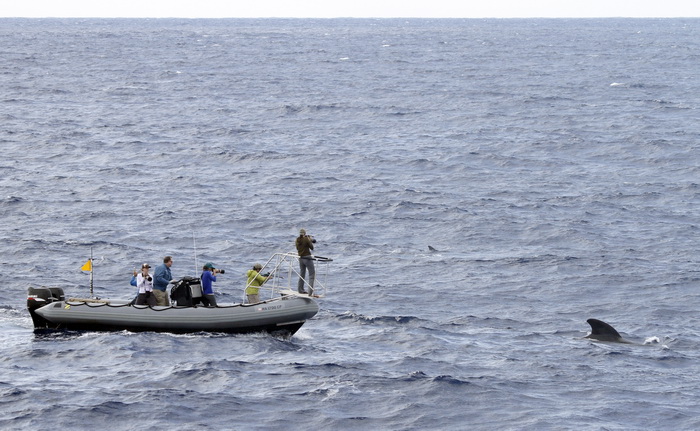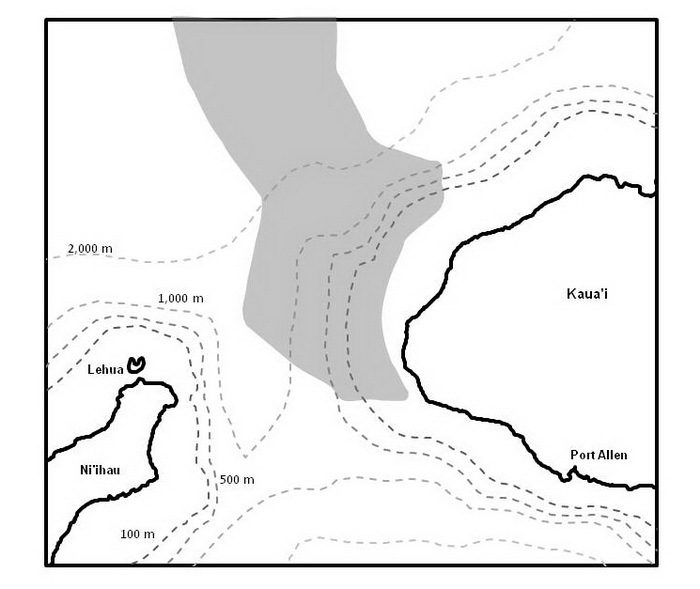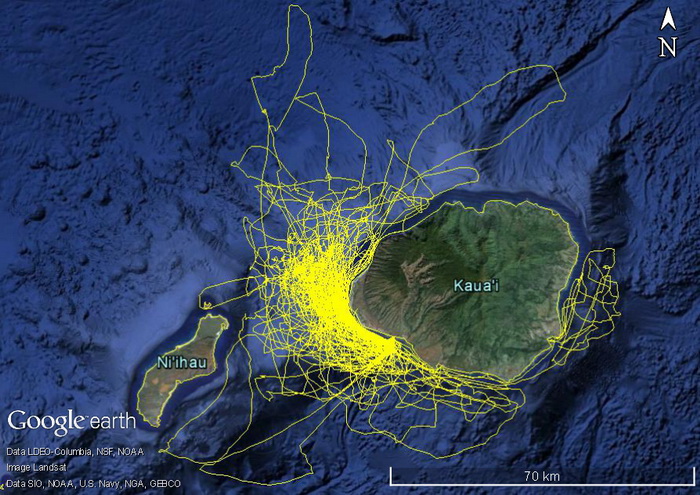Cascadia Research will be undertaking a short day field project off the island of Kaua‘i starting February 9th, 2016. This will be our 14th field project working off Kaua‘i, and our ninth year of working off the island. This project is funded by the U.S. Navy through the Marine Species Monitoring Program and by a grant from the Pacific Islands Fisheries Science Center.
The primary purpose of the project is to obtain information on movements and habitat use of a number of species of toothed whales through the deployment of satellite tags. As we do during all of our field projects, we will also be obtaining photos from most species of odontocetes we encounter, to contribute to ongoing studies of residency patterns and social organization and to estimate population sizes, and collecting biopsy samples for toxicology and genetic studies. Last year we had two similar field projects, one in February and one in September, and like those projects we expect to have higher encounter rates than normal since we’ll be working in collaboration with the Marine Mammal Monitoring on Navy Ranges (M3R) program, using the Navy’s hydrophone range off Kaua‘i (see map below) to localize animals. When on the water we will be in constant contact with Navy researchers from the M3R program to help direct us to groups that they are detecting acoustically. This will allow us to confirm the species (to aid in using the acoustic range for research purposes on different species), and should make it much easier for us to find groups of whales and dolphins for tagging, photo-ID and biopsy sampling.
Species that we are hoping to satellite tag include rough-toothed dolphins, bottlenose dolphins, false killer whales, short-finned pilot whales, melon-headed whales, pygmy killer whales, sperm whales, Cuvier’s beaked whales, and Blainville’s beaked whales.
The research team includes Daniel Webster, Brenda Rone, Kim Wood, Colin Cornforth, Robin Baird, and a number of volunteers.
February 14th update

Every day in the field we accomplish something, even if it is just survey effort with no sightings, or identification photos of a few individuals. But the overall success of each field project tends to rely on one really, really, productive day. Today was one of those. We deployed six depth-transmitting tags today on three different species: three on pilot whales (in two different groups), two on rough-toothed dolphins (in two different sub-groups), and the highlight of the day, one on a pantropical spotted dolphin.

A pantropical spotted dolphin, February 14, 2016. Photo by Kimberly A. Wood. In all our time working off Kaua‘i and Ni‘ihau we’d only seen spotted dolphins on nine occasions, and four of those nine sightings were of the same lone individual hanging out with spinner dolphins. Our last sighting of spotted dolphins off this island was on June 30, 2012, over three years ago, despite six field projects since then. Genetic evidence from biopsies we’ve previously collected off Kaua‘i suggest that the spotted dolphins here are part of an open-ocean population, rather than an island-associated population as are found off O‘ahu, Maui and Hawai‘i Islands. Today we found a group of just seven spotted dolphins, obtained one biopsy sample for genetics, and were able to deploy a satellite tag on one individual.

Movements of the satellite tagged spotted dolphin over the first 18 hours after tagging. The dolphin moved almost 120 km south of where it was tagged in this short period, providing good evidence that it is from an open-ocean population!
Feb 13th update

Short-finned pilot whale, February 13, 2016. Photo by Robin W. Baird
Overall it has been a quiet trip so far, with just four odontocete sightings in our first four days on the water. Fortunately the trend did not hold for day five – today we had five encounters with three different species of odontocetes, including large groups of bottlenose and rough-toothed dolphins, and two different groups of short-finned pilot whales. We were able to deploy two depth-transmitting satellite tags on short-finned pilot whales, so hope to be tracking this group both in terms of movements and diving behavior over the next few weeks.

Short-finned pilot whale spyhopping, February 13, 2016. Photo by Robin W. Baird.

A Laysan Albatross, February 11, 2016. Photo by Colin J. Cornforth.
Feb 11th update
In our first three days on the water we’ve encountered three of the four resident species of delphinids off Kaua’i, short-finned pilot whales, rough-toothed dolphins, and bottlenose dolphins. We were able to get good identification photos of all three species that we will match to our photo-ID catalogs.

A mother and calf short-finned pilot whale, February 11, 2016. Photo by Kim A. Wood.

A group of rough-toothed dolphins, February 11, 2016. Photo by Brenda K. Rone.

A bottlenose dolphin, February 10, 2016. Photo (c) Kim S. Rogers.

Our research vessel with short-finned pilot whales off Kaua‘i in February 2014. Photo by Jessica Aschettino.

Our study area for the project. The Navy’s hydrophone range it shaded – approximately 175 hydrophones are spread across the shaded area connected to the M3R system.

Our survey effort off Kaua‘i and Ni‘ihau over the last four years – this map shows tracklines from projects in 2012, 2013, 2014, and 2015.
Photos should not be used without permission. Contact Robin Baird (rwbaird (at) cascadiaresearch.org) for permission.
Sign up to our Facebook page if you want to receive notices of when information is posted and updates on other Cascadia projects.